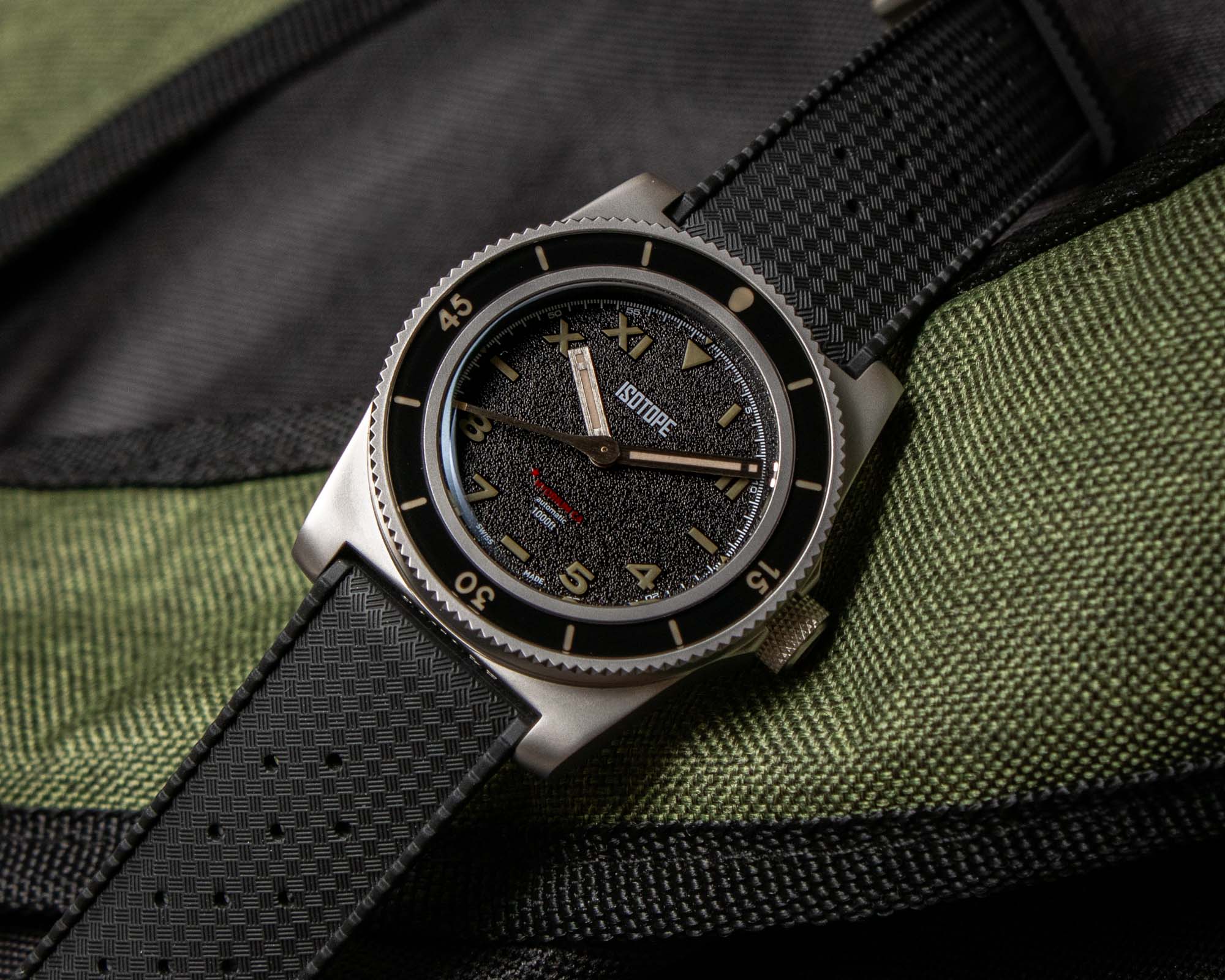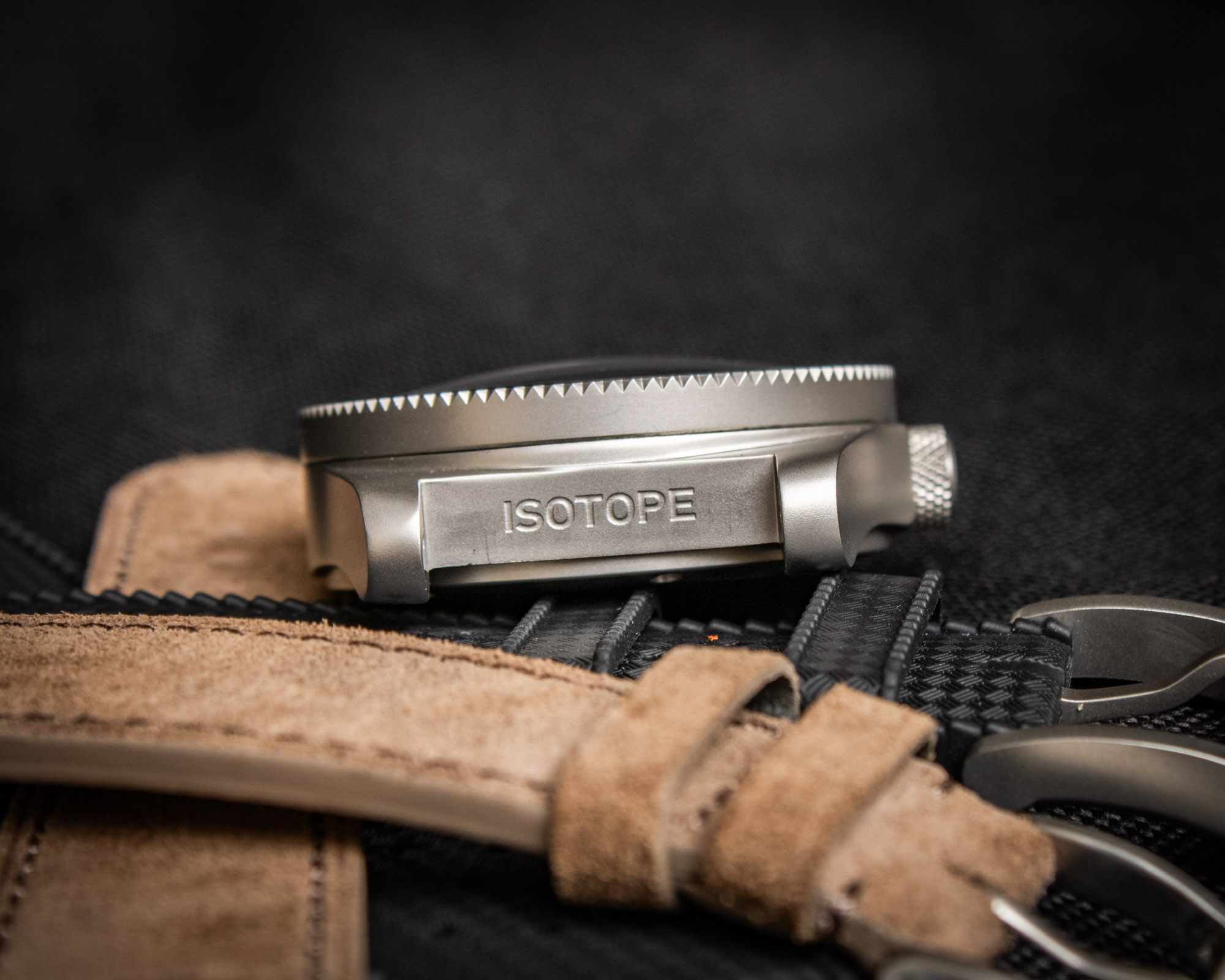
In the relatively short amount of time since making its debut appearance a couple of years ago, the Isotope Hydrium series has served as the foundation for a surprisingly diverse assortment of different models that range from purpose-built and utilitarian to whimsical and irreverent. Isotope uses the same core case design for both its Hydrium and HydriumX watches, and while it originally appeared on colorful and fairly lighthearted models, more recent releases have applied this same unconventional case silhouette to a noticeably more pared-back and traditional design language. As its latest new release of 2023, Isotope has created a new limited-edition version of its fan-favorite diver, and the Isotope Hydrium California draws its inspiration from the vintage “California Dial” dive watches that were originally used by military personnel during the 1930s and 1940s.

Now, before we get into the actual meat and potatoes of the review itself, it’s worth taking a quick look at the history of this particular style of watch dial and its seemingly unrelated “California” name. On July 15, 1942, Rolex was awarded a patent (Brevet No.221643, which is now expired) for a watch dial with Roman numeral hour markers on the top half and Arabic numerals on the bottom. Formally known as an “Error-Proof” dial within the brand’s marketing materials at the time, this particular design was specifically created to provide users a clear orientation of the time, which would help prevent them from mixing up the luminous hour markers when viewing their watches in total darkness. Although the patent wasn’t finalized until the early 1940s, this same style of dial can be found on the vintage Panerai dive watches that were manufactured by Rolex and issued to members of the Italian Navy as early as the mid-1930s.

Given that Rolex, Panerai, and the Italian Navy all have virtually nothing to do with the state of California, the next logical question is how the whole “California” moniker became attached to this unique style of watch dial. The “California” name didn’t actually come around until the 1980s when a resurgence of interest in watches as luxury items and mechanical creations brought an increase of interest to the vintage market. As the story goes, dealers were having the dials of vintage Rolex Bubble Back watches refinished to emulate this unusual and striking style (collectors cared less about originality back then), and one of the most prominent sources of these dials was a famous refinisher named Kirk Rich, who was based in California. (Kirk Rich is still in business and performs dial restorations from its California workshop today.) Within the collecting community, people started calling these restored watch faces “California dials,” and the name soon became an informal yet ubiquitous term for this unique style that combines both Arabic and Roman numeral hour markers.

As for the Isotope Hydirum California, the watch itself is based upon the overall design concept of the original vintage military timepieces that featured this style of dial, although it retains the highly rounded and almost alien case profile that unites all of the brand’s Hydrium and HydriumX models. In terms of its overall aesthetics, the Hydrium California could best be described as a cartoon drawing of a vintage Panerai diver mixed with a Blancpain Fifty Fathoms that has jumped off the page and come to life. Personally, I quite enjoy this concept, as I appreciate both of these military-issued dive watches, yet I don’t actually want something that adheres too closely to either one of them, as I have no interest in wearing an homage watch. The Isotope Hydrium California strikes a nice balance of checking a lot of similar aesthetic boxes, while still offering the brand’s signature design DNA, and the end result is one of the more traditional and versatile renditions of the Hydrium that Isotope has ever put forward.
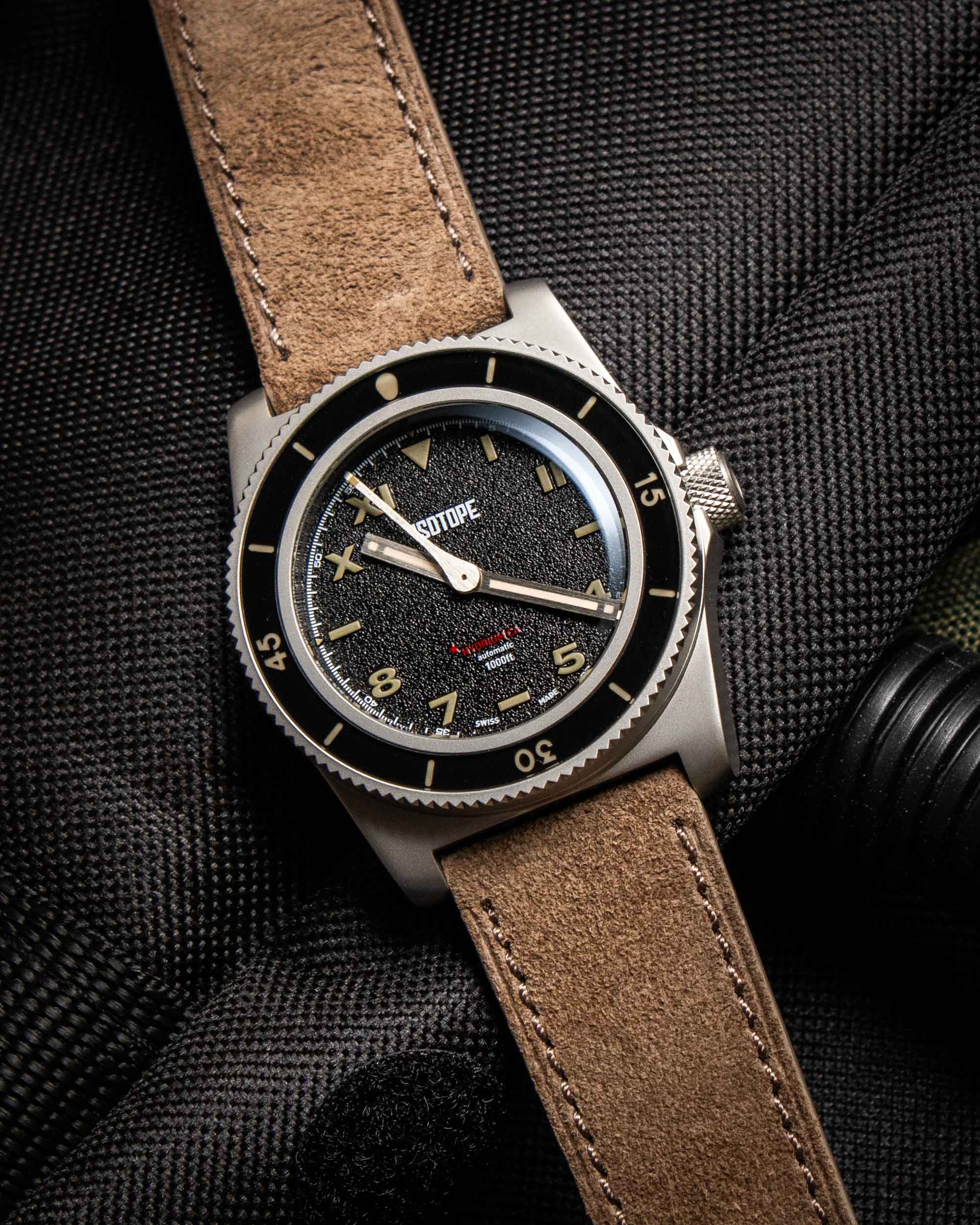
In terms of its overall design and construction, the new Isotope Hydrium California features the same micro-blasted 316L stainless steel case as its Hydrium and HydriumX siblings, which measures 40mm in diameter by 12.9mm thick, with 22mm lugs and an overall lug-to-lug profile of 48mm. The top of the case is fitted with a double-domed sapphire crystal (with anti-reflective treatment) that sticks up above the rim of the bezel and brings the overall height of the watch up to 14.9mm. Meanwhile, the bezel features a 120-click unidirectional rotating design that offers a crisp and satisfying action with virtually zero slack whatsoever. Similar to the Isotope HydriumX “The Judge” I reviewed last year, the new Hydrium California features a sapphire bezel insert, but rather than adhering to a highly minimalist and largely sterile design, the black sapphire insert features luminous markings every five minutes, with Isotope’s signature lacrima (teardrop) logo occupying the zero marker and Arabic numerals placed at the remaining cardinal points.
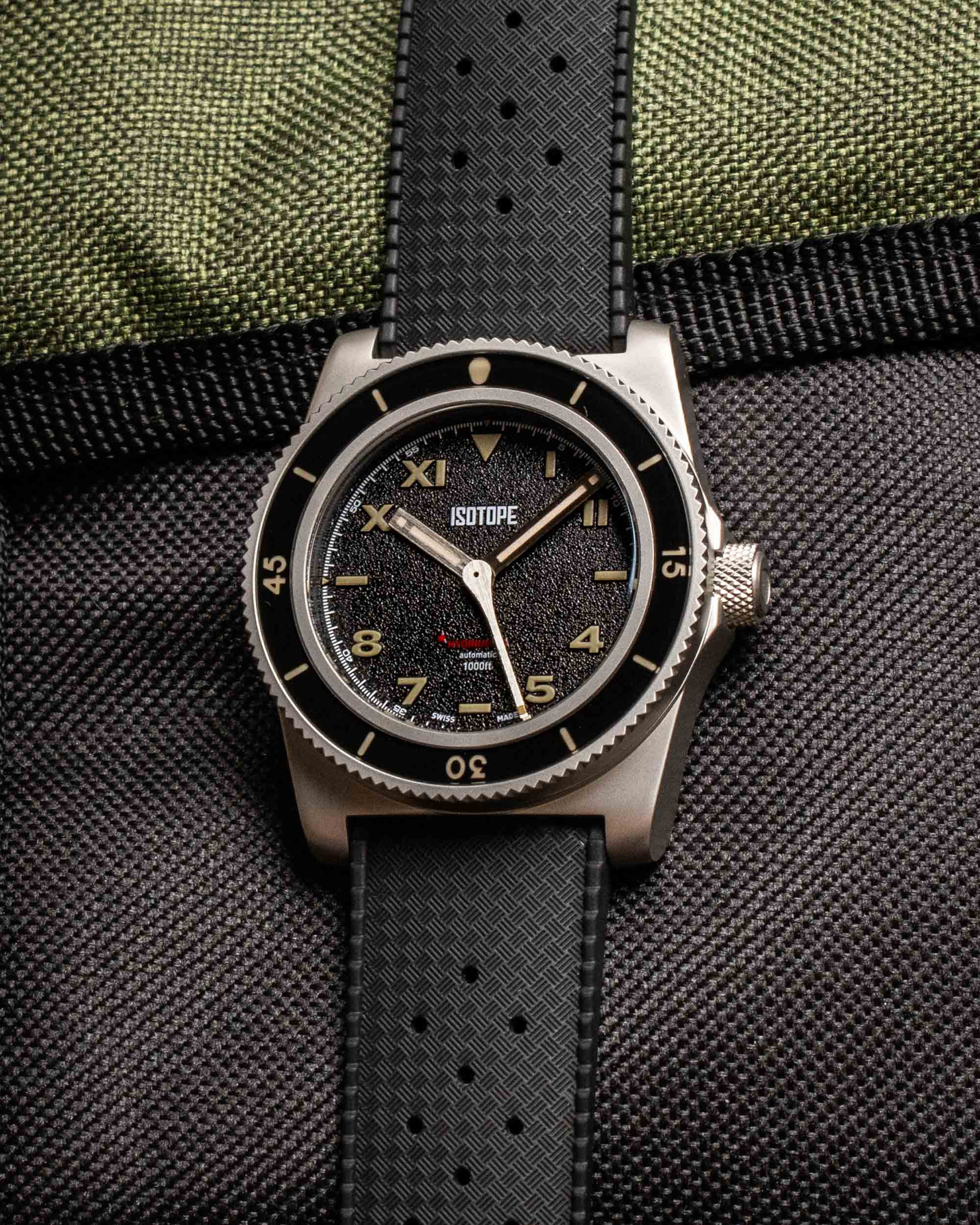
Compared to the ultra-minimalist bezels that are fitted to most of the other Hydrium and HydriumX models, the additional markings on the bezel insert of the new Isotope Hydrium California make the task of tracking elapsed time significantly easier. Additionally, while the resulting aesthetic is inherently more traditional compared to the largely sterile bezels of its siblings, this will likely be a welcome detail for those who appreciate Isotope’s design language but want something a bit more pared-back and conventional. In terms of its external construction, the rest of the Isotope Hydrium California is identical to its siblings, and it features a signed screw-down crown at 3 o’clock that is protected by a small set of guards, along with a screw-down display caseback that features a circular sapphire window and helps ensure the watch’s 300 meters of water resistance.
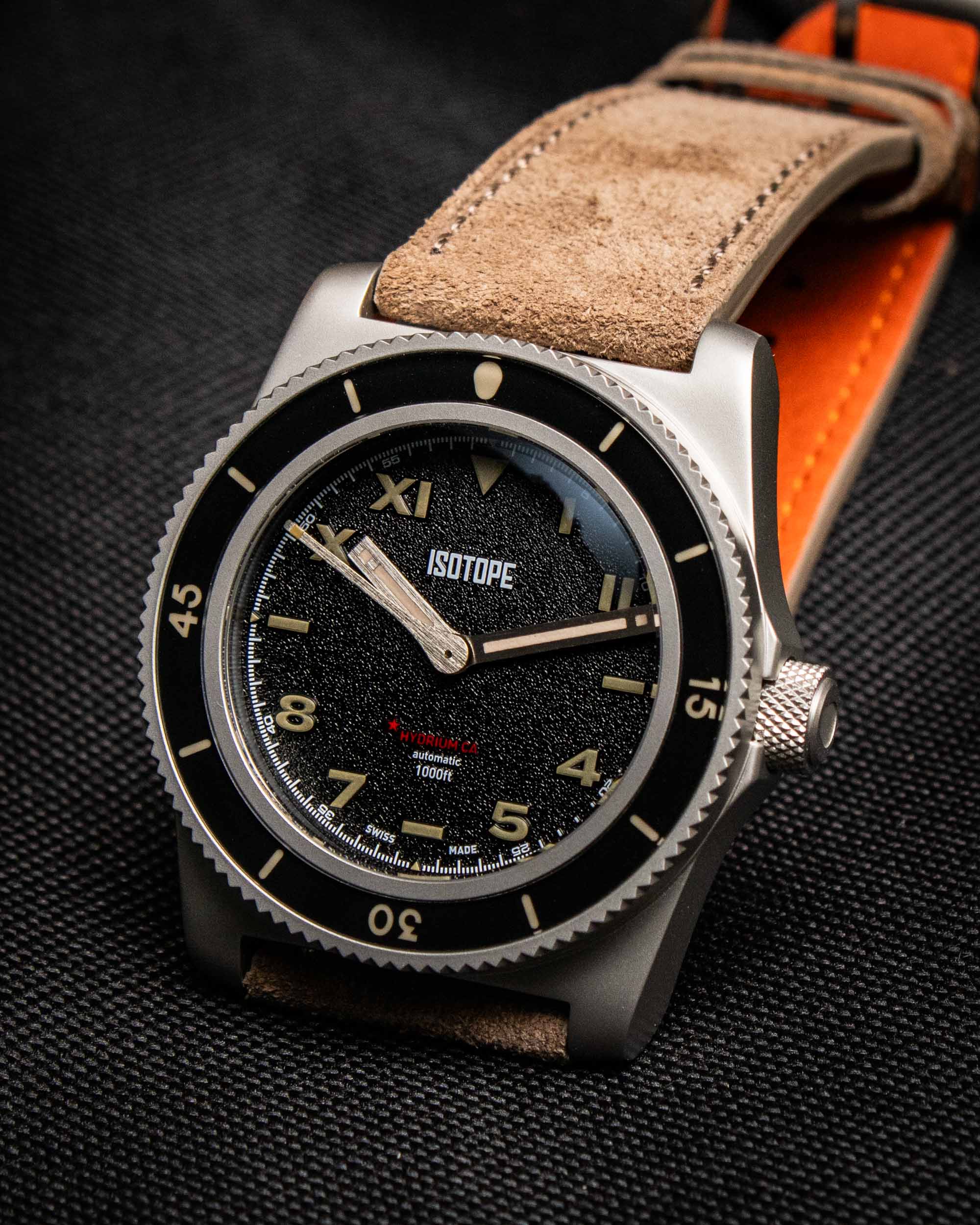
While the redesigned bezel insert represents an aesthetic departure from its predecessors, the dial of the Isotope Hydrium California is the single most significant detail that separates this new model from previous Hydrium watches. Unlike most of its siblings, the Hydrium California omits the raised lacrima motif in the center and instead opts for a flat matte black surface that showcases a rough grainy texture. The raised Arabic and Roman numeral markers are filled with khaki-colored Super-LumiNova to match the luminous markings on the bezel, while the Isotope name, depth rating, and minute track are all printed in crisp white for maximum contrast. As a small splash of color and a subtle nod to the unofficial “California” moniker of this style of dial, the “Hydrium” name appears in bright red letters, and it is accompanied by both the star from the California state flag and the letters “CA” next to it. As a resident of California, I might be a little biased, although I personally enjoy this small detail quite a bit, since it requires less text than printing the full “Hydrium California” name and offers a cleaner, less text-heavy overall appearance.

Rather than featuring the same style of handset that can be found on the various HydriumX models (which is inspired by the hands of the famous “Will Return” signs that hang in store windows around the world), the Isotope Hydrium California receives the brand’s “i” shaped hands, which offer superior at-a-glance legibility and are the style typically chosen for the brand’s Hydrium models. The handset on the Hydrium California is flat with a linear brushed finish, and while the hour and minute hands offer an i-shaped profile, the seconds hand appears as an elongated teardrop shape without any type of counterweight as a reference to Isotope’s lacrima logo. Additionally, just like the indexes and bezel markings, all three of the centrally-mounted hands feature khaki-colored Super-LumiNova accents to increase their low-light visibility. While the lume on the hands is slightly brighter than the hour markers, referencing the time in the dark is still an easy task, and the multiple luminous elements provide a visually pleasing, green-glowing display.

Just like the rest of the brand’s time-only models, the Isotope Hydrium California is powered by the Swiss Landeron 24 automatic movement, which is based upon the same core architecture as the ETA 2824 or Sellita SW200 and therefore runs at a frequency of 28,800vph (4 Hz) with a power reserve of approximately 40 hours. While the underlying design of the Landeron 24 is very much a known quantity and its specifications are fairly standard, this particular movement does offer a few superior characteristics compared to the base-level versions of its ETA or Sellita counterparts. In addition to offering an accuracy rating of -12/+12 seconds per day, the Landeron 24 that Isotope uses is a proper time-only movement, meaning that the Hydrium California doesn’t have the dreaded “ghost position” that often accompanies no-date watches that run on standard off-the-shelf movements. Additionally, the Landeron 24 also benefits from superior finishing compared to the base-level offerings from ETA or Sellita, and it features perlage on the plates and bridges, blued screws, and a custom rotor with Geneva stripes that is signed with Isotope’s lacrima logo.

Fitted to the rounded lugs of the Isotope Hydrium California is a black FKM tropic rubber strap that tapers from 22mm at the case down to 20mm where it connects to its chunky tang-style buckle. The rubber strap is quite comfortable and virtually identical to what can be found on other Hydrium and HydriumX models, although rather than being signed with the Isotope name, the micro-blasted stainless steel buckle is adorned with the brand’s lacrima logo. With that in mind, for a small premium, buyers have the option to swap out the standard black FKM rubber strap for a tan suede alternative that features a slightly shorter design paired with a more rounded lacrima-signed pin buckle. Additionally, for buyers who can’t choose between the two different straps, the Hydrium California can also be purchased with both options, and the two straps feature integrated quick-release springbars that allow them to be easily swapped back and forth without the use of any tools.

California dials are a bit of an acquired taste, and the combination of Arabic and Roman numeral markers (plus whatever other text might accompany them) can sometimes feel a bit disjointed if the different styles of typography don’t work together to create a harmonious overall appearance. That said, I personally feel that the Isotope Hydrium California is one of the more successful renditions of this particular aesthetic, and the pairing of a vintage-inspired dial with the brand’s decidedly modern case profile creates a fresh and intriguing take on this familiar and historic concept. Similar to California dials, Isotope’s design language can also be a bit divisive, and one of the most common critiques of the brand is that a number of its models are simply too “out there” and unconventional for some collectors. While Isotope’s colorful and slightly irreverent designs are still the brand’s primary calling card, there is also certainly something to be said for its more pared-back models like the Hydrium California, which offer greater widespread appeal and can more easily integrate into everyday life.

As Isotope’s Hydrium series continues to expand and evolve, the diversity of the collection steadily increases, and models like the Hydrium California represent a stark contrast compared to the original “Will Return” model that first introduced this now-signature case profile. Additionally, since the primary differences between the various Hydrium and HydriumX models are their dials, hands, bezel inserts, and straps, the difference in cost between them is minimal, and the new Isotope Hydrium California is accompanied by an official retail price of £900 GBP (or about $1,150 USD, at the time of writing), which places it right in-line with the rest of its siblings. At the end of the day, the Hydrium California is hardly Isotope’s most original or outlandish design, although this also makes it one of the brand’s most versatile models, and I could easily see this watch being a person’s trusted everyday timekeeping companion. For more information on the Isotope Hydrium California, please visit the brand’s website.




